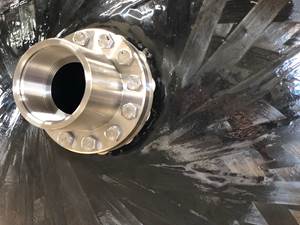Clemson researchers developing composite materials from trees
Researchers want to use the composite materials to make bumpers and fenders that will be less likely to distort or break on impact.
Trees that are removed during forest restoration projects could find their way into car bumpers and fenders as part of a study led by Srikanth Pilla of Clemson University, according to a news release from the university.
Pilla is collaborating on the study with researchers from the USDA Forest Service’s Forest Products Laboratory in Madison, Wisc.
They are converting some of those trees into liquid suspensions of tiny rod-like structures with diameters 20,000 times smaller than the width of a human hair. Pilla is using these tiny structures, known as cellulosic nanomaterials, to develop new composite materials that could be shaped into automotive parts with improved strength.
The auto parts would also be biorenewable, which means they could go to a composting facility instead of a landfill when their time on the road is done. The research could help automakers meet automotive recycling regulations that have been adopted in Europe and could be on the way to the U.S.
Pilla, an assistant professor in the automotive engineering department at Clemson University, wants to use the composite materials he is creating to make bumpers and fenders that will be less likely to distort or break on impact.
“They will absorb the energy and just stay intact,” he said. “You won’t have to replace them because there will be no damage at all. Parts made with current materials might resist one impact. These will resist three or four impacts.”
The U.S. Department of the Agriculture’s National Institute of Food and Agriculture is funding the $481,000 research project for five years. Pilla’s research will be based out of the Clemson University International Center for Automotive Research in Greenville, South Carolina.
Craig Clemons, a materials research engineer at the Forest Products Laboratory and co-principal investigator on the project, said that the Forest Service wants to find large-volume uses for cellulosic nanomaterials.
“We find appropriate outlets for all kinds of forest-derived materials,” he said. “In this case, it’s cellulosic nanomaterials. We’re trying to move up the value chain with the cellulosic nanomaterials, creating high-value products out of what could otherwise be low-value wood. We’ll be producing the cellulosic nanomaterials, which are the most fundamental structural elements that you can get out of wood and pulp fibers. We’ll also be lending our more than 25 years of experience in creating composites from plastics and wood-derived materials to the project.”
The cellulosic nanomaterials could come from trees that are removed during forest restoration projects. Removing this material from the forests helps prevent large, catastrophic wildfires. Researchers will have no need to cut down healthy trees that could be used for other purposes, Pilla said.
One of the technical challenges Pilla and Clemons face in their work is combining the water-friendly cellulosic nanomaterials with the water-unfriendly polymers. They will need to show that the material can be mass produced because automakers need to make thousands of parts.
“We will use supercritical fluid as a plasticizer, allowing the nanoreinforcements to disperse through the polymer,” Pilla said. “We can help develop a conventional technique that will be scalable in the automotive sector.”
Related Content
Plant tour: Teijin Carbon America Inc., Greenwood, S.C., U.S.
In 2018, Teijin broke ground on a facility that is reportedly the largest capacity carbon fiber line currently in existence. The line has been fully functional for nearly two years and has plenty of room for expansion.
Read MoreOtto Aviation launches Phantom 3500 business jet with all-composite airframe from Leonardo
Promising 60% less fuel burn and 90% less emissions using SAF, the super-laminar flow design with windowless fuselage will be built using RTM in Florida facility with certification slated for 2030.
Read MoreInfinite Composites: Type V tanks for space, hydrogen, automotive and more
After a decade of proving its linerless, weight-saving composite tanks with NASA and more than 30 aerospace companies, this CryoSphere pioneer is scaling for growth in commercial space and sustainable transportation on Earth.
Read MorePlant tour: Airbus, Illescas, Spain
Airbus’ Illescas facility, featuring highly automated composites processes for the A350 lower wing cover and one-piece Section 19 fuselage barrels, works toward production ramp-ups and next-generation aircraft.
Read MoreRead Next
Scaling up, optimizing the flax fiber composite camper
Greenlander’s Sherpa RV cab, which is largely constructed from flax fiber/bio-epoxy sandwich panels, nears commercial production readiness and next-generation scale-up.
Read MoreUltrasonic welding for in-space manufacturing of CFRTP
Agile Ultrasonics and NASA trial robotic-compatible carbon fiber-reinforced thermoplastic ultrasonic welding technology for space structures.
Read MoreCeramic matrix composites: Faster, cheaper, higher temperature
New players proliferate, increasing CMC materials and manufacturing capacity, novel processes and automation to meet demand for higher part volumes and performance.
Read More












